Because Super Metroid hails from the mid-’90s rather than the mid’-80s like most of the games that have gone under the Anatomy of a Game microscope, it follows slightly different rules. Games like Super Mario Bros. and Castlevania and even the original Metroid were, on some level, compensating for the fact that many people who picked up those adventures had little to no experience with video games in general and those specific genres in particular. By 1994, Nintendo could rest secure in the knowledge that the vocabulary of video games had become somewhat common parlance, especially for the sort of people who were going to buy Super Metroid. So it doesn’t have to be quite as instructional, and after the first hour or so it stops guiding you in the right direction and leaves you to your own devices.
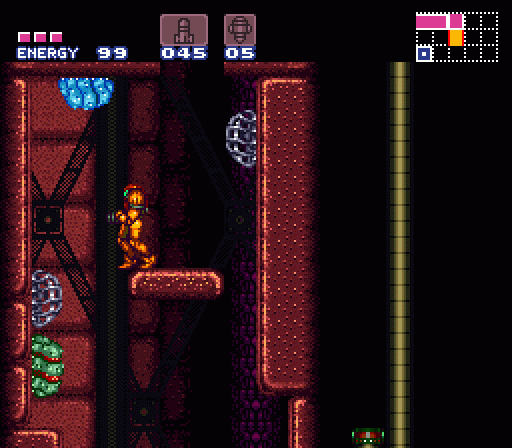
Your next major goal in the game is to reach the enticing submerged cavern you saw through the glass tube in Brinstar, but before you can reach that point you need to accomplish quite a few things. The sub-goals you specifically need to complete in order to enter the Maridia zone are not stated explicitly. Nor are you nudged toward your next goal, at least not overtly. Once you have the Ice Beam, Super Metroid sort of steps back and lets you work it out for yourself.
At this point you’ll have encountered a number of points of interest that you couldn’t activate or explore with the gear you have at the time, but with the ability to climb back up that long drop in the central Brinstar shaft you can begin revisiting them and harvesting the goods that were just out of reach before. Still, there’s one key tool missing from your inventory at this point, and the game gives you one final push in the right direction: You can find the Power Bombs at the top end of the tall Brinstar shaft. You don’t have to climb that high, of course; you can duck left and retrace your steps. But there’s this new area you couldn’t quite get to before just a screen away from the door to the westward territory you’ve already explored. Why wouldn’t you want to see what’s there?
This annex repeats the melancholic motif of the tall shaft, with subdued music, earthy colors, and a dim light in the background that slowly pulses on and off. And a few rooms later, you suddenly find yourself boxed into another shorter shaft, unable to advance or retreat due to the fact that both the upper and lower doors are sealed over with yellow barriers — a door shield you don’t have the ability to break through just yet.
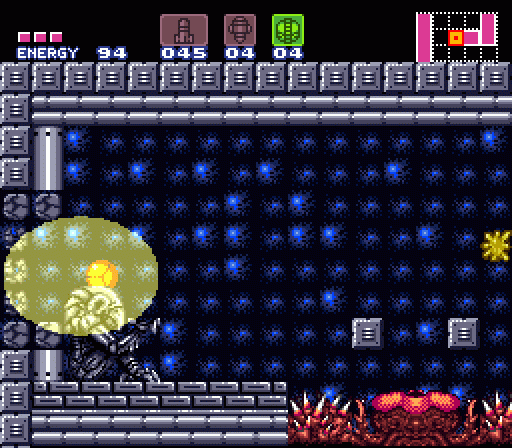
How fortuitous, then, that within this boxed-in area you can find the solution to your troubles: The aforementioned Power Bomb. The Power Bomb breaks yellow doors, clears away “power bomb” blocks, and wipes out almost every enemy on screen (save some of the really heavy-hitters). If you drop a Power Bomb as soon as you collect the first one, you’ll blast through a wall that leads to a second pick-up.
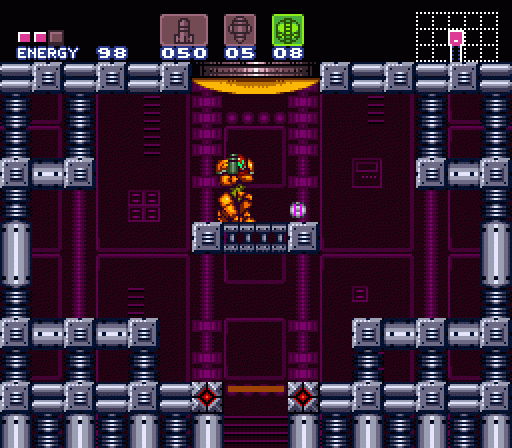
And you can also open the door above, completing the loop back into Crateria and the initial landing zone. Follow that around and you’ll be able to complete a circuit of the ground you’ve explored so far, uncovering a number of those power-ups you had to forego the first time around. Isn’t that so much better than if you had gone left from the tall shaft only to reach the yellow door on the surface and being forced to double back?
Alternately, with the Power Bomb in hand, you can also return to that glass tube from before and shatter it with a room-filling explosion…

…but sadly, this area is submerged in water, which greatly hampers Samus’ movement at the moment. There’s not much to do here in the water but feel frustrated at how poorly you jump in this environment before heading back to dry land.
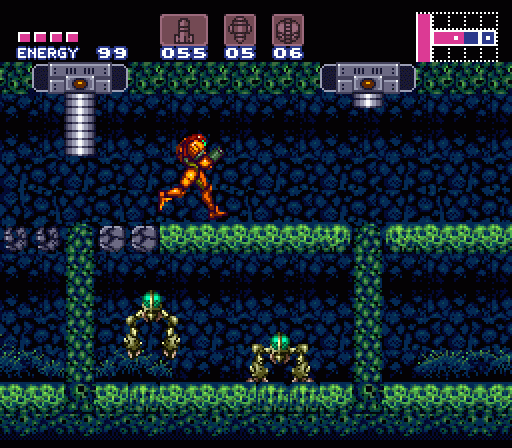
You’ll find more satisfaction in areas for which you’re better prepared this time around, such as the room with the rapidly descending gates over crumbling ground. With the Speed Booster equipped, Samus can outrace the gates and reach the other side…

Where a new item awaits: The reserve tank. A reserve tank works more or less like a basic Energy Tank, except that its juice isn’t counted toward Samus’ health. And to fill it, you need to top off your primary health first; once you’re maxed out, then you’ll begin filling your reserve. When you take damage, however, it comes off your primary health. The reserve doesn’t kick in unless your energy is whittled down to zero, at which point the extra tank will recharge your main energy battery for the current amount in reserve. It’s basically a second wind in case of disaster.
However, the reserve tank chamber also contains one of my favorite Super Metroid secrets. Hidden behind the reserve tank through the somewhat obvious silver pipe leading off-screen is a secret room where you can collect a missile.

But behind that secret is a second secret: Another missile tank hidden inside the wall. Since you’ve just collected one obscure power-up, it might not occur to you to look for another so close. Super Metroid rewards the thorough.
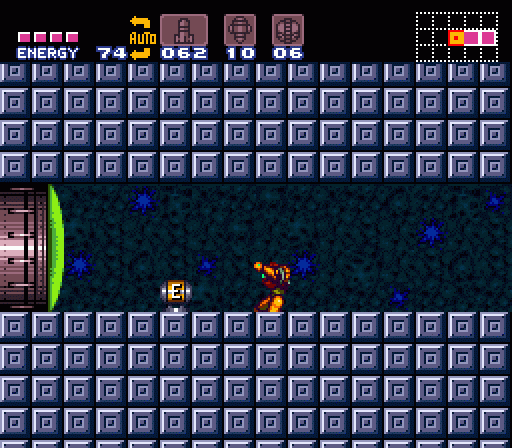
Among other fun things you can encounter is another direct reference to Kraid’s lair in the NES game: An Energy Tank just sitting out in the middle of a corridor… right next to a hidden pit that causes you to plummet into an out-of-the-way room. You get greedy, you get careless. It’s possible to snag this tank if you know about the pitfall. If you remember the original Metroid, it’s definitely a fool-me-twice moment of shame — another clever callback, but this time less “Oh cool” than “Oh man, I’m an idiot.”
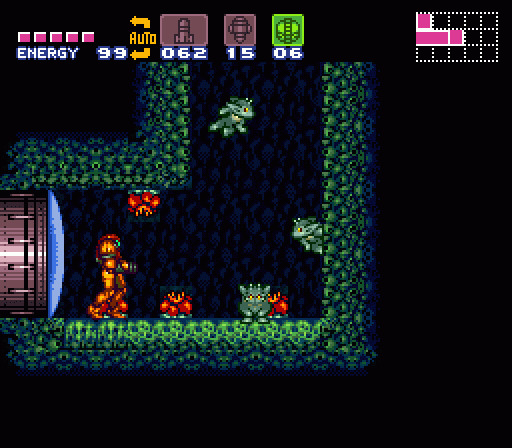
And yet, there’s wisdom to be gained in folly, as the hidden passage below is hope to a trio of friendly aliens who teach Samus about one of her hidden powers: The wall jump. This skill isn’t something you’re likely to stumble into on your own — on the off chance you accidentally activate it, you’ll probably think it’s some kind of fluke. But here, these helpful little fellows give you an overt tutorial on how to execute a triangle jump. The timing takes practice, but there’s no threat in this passage…
…and if the timing proves too difficult for you to master, that’s OK, too. As long as you’re able to pull off a single wall jump, there’s a ledge directly above that contains a passage back to the entrance. On the other hand, if you ace it, you can really show off by making an almost impossible jump to a small room at the top of the shaft here where another Power Bomb awaits.
On the other hand, you can complete the game without ever seeing this tutorial or learning about Samus’ ability to climb walls. This area is hidden away in a fairly obscure area that’s only likely to be found by someone making a comprehensive effort to comb the caverns for every possible upgrade: A power move for power players.
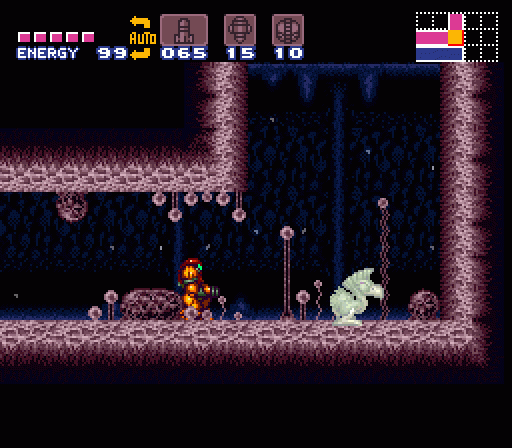
Likewise, a second tutorial appears nearby in another totally optional area. You need to break through a chunk of floor with a Speed Booster dash to find a bird who teaches you to use the advanced “shine spark” technique, which allows Samus to store up a Speed Boost charge for a moment and redirect it in order to “fly.”
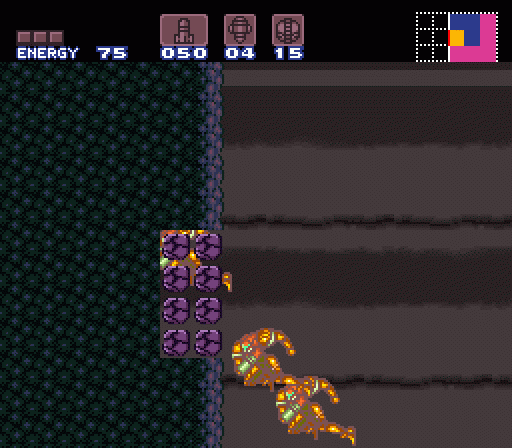
If you’re really awesome, you can even pull it off at a 45-degree angle and crack open a hidden passage up above the landing area at the beginning of the game long before you should be able to reach that secret area. Again, this technique isn’t essential to completing the game, and you can easily go your whole life without ever knowing it’s even possible. But while the tutorial is hidden, it’s tucked away in a manner that you can very easily luck into — the Speed Booster blocks you drop through sit next to an inconvenient chunk of bombable rock sitting in the midst of a long, flat, horizontal passage. You can just bomb it or even Power Bomb it, but why not just get a running start and dash through it? And when you do, you’ll learn about a hidden feature of the game. Such elegant design.
And of course, all of this is a sideshow. Once you have the Power Bomb, you really should be dropping back into Norfair to find the Grapple Beam so that you can clear the passage to the east of the landing spot in Crateria. But finally, Super Metroid lets you figure that out on your own. In exploring old ground, you’ll eventually find the way forward, but you’ll also uncover all this other cool stuff. Super Metroid is confident enough in your intelligence that it goes hands-off here. It believes in you.
When I was younger, I had to restart the game due to that damn save point by the Wall Jump Tutorial room.
I’m here for ya, buddy.
Oh man, I love this part of the game more and more every time I replay it. The sense of independence is just great. You’re alone on this alien world, but it’s OK because you’re beginning to make it adapt to you instead of the other way around.
Doing the shine spine spark now seems so easy, why was it so tough for 13 year old me to figure out?
At least I was able to catch on to I was supposed to mimick the space ostrich.
I loved how the game tells-you-without-telling-you that you can shatter that tube in Meridia: another section you can stumble onto has an already broken tube.
Hey, I have not posted here since the Castlevania 3 anatomy, but I am catching back up. I’d like to state once again how much I greatly enjoy this series, and taking a look at my favorite games and breaking down why they work, or in some cases, why things don’t work.
This is also perhaps my favorite part of Super Metroid. The true joy of Metroid and similar games is seeing the game world tease you that there’s so much more to see, and then finally figuring out how to get there. The game world opens up so much at this point, as you can finally reach a lot of areas that you have missed out on in Crateria and Brinstar, while being able to more adeptly handle any enemies or obstacles. I love the feeling of returning to Samus’ ship, much more powerful then when you touched down, while the Crateria overworld music plays. The player starts to feel very empowered, and is rewarded for his or her’s intuition in trying to locate hidden items and passages. At this point, the player is encouraged to keep searching for more, as you know that nothing is out of reach.
J.Parish, would you ever take a look at the Metroid Prime games? Specifically, the first one? I played it incessantly when it first came out, and I replayed it again two years ago. On that replay, it really struck me just how well Metroid’s level design was integrated into a 3D world. While the Prime games focus more on puzzles, if you take a look at the game world’s structure, everything is all there.
I dunno, games of that vintage are a lot harder to get useful screens for, so that would really hamper an anatomy series.
Recalling to my comment at the last anatomy. I checked the maps and you were right. You require either the power bombs or the wave beam to reach Crocomire in Norfair. My memory tricked me there.
And, oh man, that wall jump shaft! I remember how long it took me to get to the top with the power bomb update! But if my memory does not trick me again, could it be that the wall jump is much easier to pull off in more recient entries like Fusion or Zero Mission?
However, teaching the player these special techniques non-verbal via the friendly animals is just fantastic game design. The final secret techniques, the energy refill via power bombs, is not shown in-game as I recall, its existence is however hinted/shown in the game demo when you don’t touch the Start Screen. Or is there something in-game showing it besides that?